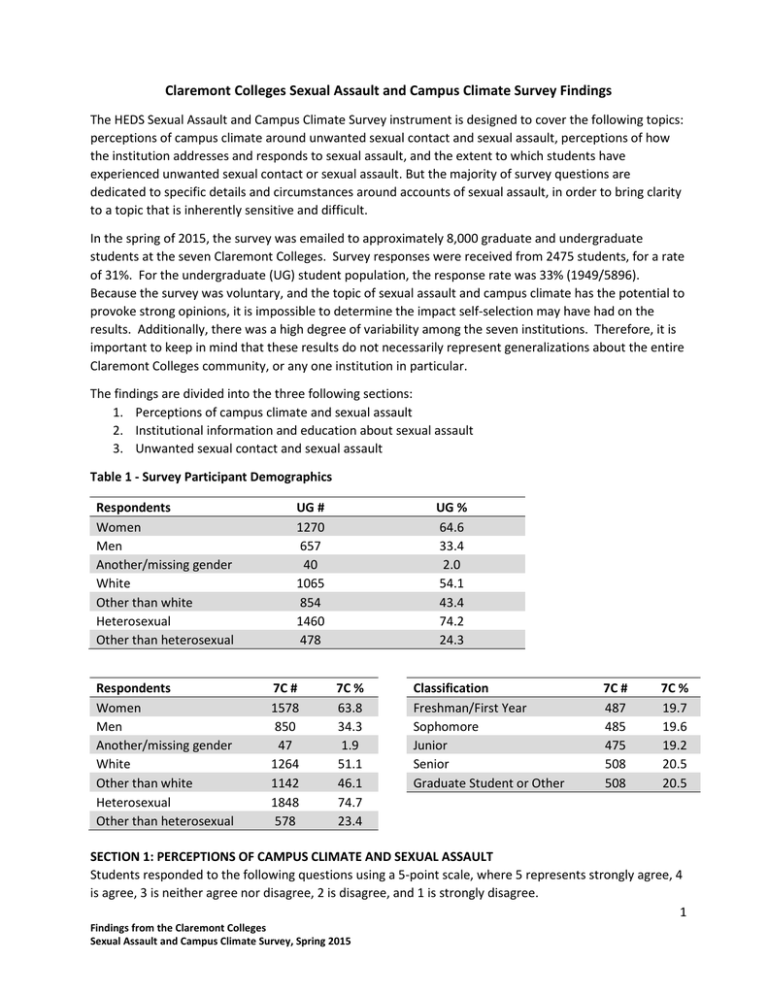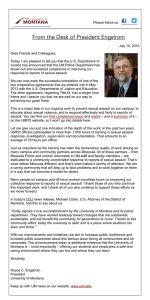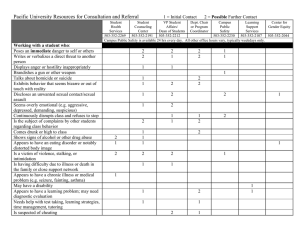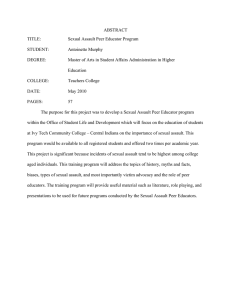
Claremont Colleges Sexual Assault and Campus Climate Survey Findings
The HEDS Sexual Assault and Campus Climate Survey instrument is designed to cover the following topics:
perceptions of campus climate around unwanted sexual contact and sexual assault, perceptions of how
the institution addresses and responds to sexual assault, and the extent to which students have
experienced unwanted sexual contact or sexual assault. But the majority of survey questions are
dedicated to specific details and circumstances around accounts of sexual assault, in order to bring clarity
to a topic that is inherently sensitive and difficult.
In the spring of 2015, the survey was emailed to approximately 8,000 graduate and undergraduate
students at the seven Claremont Colleges. Survey responses were received from 2475 students, for a rate
of 31%. For the undergraduate (UG) student population, the response rate was 33% (1949/5896).
Because the survey was voluntary, and the topic of sexual assault and campus climate has the potential to
provoke strong opinions, it is impossible to determine the impact self-selection may have had on the
results. Additionally, there was a high degree of variability among the seven institutions. Therefore, it is
important to keep in mind that these results do not necessarily represent generalizations about the entire
Claremont Colleges community, or any one institution in particular.
The findings are divided into the three following sections:
1. Perceptions of campus climate and sexual assault
2. Institutional information and education about sexual assault
3. Unwanted sexual contact and sexual assault
Table 1 - Survey Participant Demographics
Respondents
Women
Men
Another/missing gender
White
Other than white
Heterosexual
Other than heterosexual
Respondents
Women
Men
Another/missing gender
White
Other than white
Heterosexual
Other than heterosexual
UG #
1270
657
40
1065
854
1460
478
7C #
1578
850
47
1264
1142
1848
578
UG %
64.6
33.4
2.0
54.1
43.4
74.2
24.3
7C %
63.8
34.3
1.9
51.1
46.1
74.7
23.4
Classification
Freshman/First Year
Sophomore
Junior
Senior
Graduate Student or Other
7C #
487
485
475
508
508
7C %
19.7
19.6
19.2
20.5
20.5
SECTION 1: PERCEPTIONS OF CAMPUS CLIMATE AND SEXUAL ASSAULT
Students responded to the following questions using a 5-point scale, where 5 represents strongly agree, 4
is agree, 3 is neither agree nor disagree, 2 is disagree, and 1 is strongly disagree.
1
Findings from the Claremont Colleges
Sexual Assault and Campus Climate Survey, Spring 2015
General views on campus climate are very positive. Over 90% of all 7C respondents agree or strongly
agree that they feel safe on their campus; that figure is 80% for undergraduate respondents only.
Table 2 - Responses to questions about General Climate
Questions about general climate
Faculty, staff and administrators respect what students think
Faculty, staff, and administrators concern for students' welfare
Faculty, staff, and administrators treat students fairly
Student concern about welfare of other students
I feel valued in the classroom/learning environment
I feel close to people on this campus
I feel part of the community
I feel safe on this campus
UG Mean
3.98
4.22
3.93
4.17
4.19
4.11
4.00
4.34
7C Mean
4.01
4.21
3.96
4.12
4.19
4.01
3.94
4.34
However, differences were observed among various populations.
Chart 1 - Disaggregated responses to the statement I feel safe on this campus
Men
White
Heterosexual
All respondents
Other than White
Women
Other than heterosexual
4
3.93
Another/missing gender
1
1.5
2
2.5
UG
3
3.5
4
4.55
4.52
4.44
4.43
4.41
4.4
4.34
4.34
4.25
4.25
4.25
4.25
4.16
4.15
4.5
5
7C
Views about the institutional response to difficult or dangerous situations are slightly lower than those on
campus climate, but remain positive.
Table 3 - Responses to questions about difficult or dangerous situations
Difficult or dangerous situations
Officials protect students from harm
Officials would handle a crisis well
Officials respond quickly in difficult situations
Officials handle in fair and responsible manner
There is a good support system for students going through difficult times
Findings from the Claremont Colleges
Sexual Assault and Campus Climate Survey, Spring 2015
UG Mean
3.68
3.47
3.51
3.48
3.44
7C Mean
3.72
3.54
3.54
3.51
3.47
2
While most respondents from the 7Cs (including undergraduates) believe that other students would
intervene if they witnessed a sexual assault, 39% 7C (42.2% UG) still think that they or one of their friends
is at risk for being sexually assaulted on campus or during off-campus events or programs sponsored by
the institution. Just over half of 7C students (46.5% UG only) perceive the number of sexual assaults that
occur on campus or during off-campus events or programs sponsored by their institution to be low.
Table 4 - Responses to questions about views on sexual assault
Views on sexual assault at institution
Low number of sexual assaults on campus
Don't believe I or one of my friends is at risk of sexual assault
Students would intervene if they witnessed a sexual assault
UG Mean
3.29
2.95
3.78
7C Mean
3.42
3.11
3.82
Once again, differences were observed among certain populations.
Chart 2 - Disaggregated responses to the statement I believe that students would intervene if they
witnessed a sexual assault
Men
White
Heterosexual
All respondents
Other than White
Women
Other than heterosexual
3.41
3.39
Another/missing gender
1
1.5
2
2.5
UG
3
3.94
3.98
3.81
3.82
3.83
3.87
3.78
3.82
3.75
3.82
3.71
3.74
3.64
3.65
3.5
4
4.5
5
7C
SECTION 2: INSTITUTIONAL INFORMATION AND EDUCATION ABOUT SEXUAL ASSAULT
Responses regarding information and education on sexual assault provided by institution varied.
Table 5 - Responses to questions about information or education
UG: Did you receive information or education from institution about
What sexual assault is and how to recognize it
How to report an incident of sexual assault
Confidential resources for sexual assault and how to locate them
Procedures for investigating a sexual assault
Action you can take to help prevent sexual assault
Findings from the Claremont Colleges
Sexual Assault and Campus Climate Survey, Spring 2015
% Yes
85.6
59.5
59.4
37.7
77.2
% No
6.6
19.6
19.4
40.3
12.6
% Unsure
7.0
20.0
20.3
21.0
9.3
3
7C: Did you receive Information or education from institution about
What sexual assault is and how to recognize it
How to report an incident of sexual assault
Confidential resources for sexual assault and how to locate them
Procedures for investigating a sexual assault
Action you can take to help prevent sexual assault
% Yes
74.8
55.0
53.2
33.7
67.2
% No
13.3
23.2
23.5
42.2
18.9
% Unsure
10.8
20.5
22.1
22.9
12.6
Chart 3 - Respondent recollection and ratings of institutional information and education
How much of the info/education
do you remember?
50%
44%
40%
40%
28% 27%
10%
Some of it
14% 12%
10%
0%
UG
29% 26%
20%
6% 7%
Most of it
41%
30%
15% 12%
Almost all
45%
50%
37%
30%
20%
How helpful was the
info/education?
4% 4%
0%
Very little
or none
Very helpful
Helpful
7C
UG
Slightly
helpful
Not helpful
7C
SECTION 3: UNWANTED SEXUAL CONTACT AND SEXUAL ASSAULT
Most respondents have never experienced unwanted sexual contact in the forms defined below.
Chart 4 – Frequency of unwanted sexual contact while on campus or while off campus during events or
programs sponsored by the institution
UG Unwanted Sexual Contact
100%
77%
80%
60%
51%
43%
40%
29%
25%
14%
20%
18%
15%
5%
5%
0% 4%
0%
Never
Rarely
Verbal
Findings from the Claremont Colleges
Sexual Assault and Campus Climate Survey, Spring 2015
Sometimes
Nonverbal
Often
1% 0% 1%
Very Often
Brief physical
4
7C Unwanted Sexual Contact
100%
79%
80%
60%
50%
59%
40%
26%
20%
12%
21%
16%
4%
12%
0%
Never
Rarely
Verbal
Sometimes
Nonverbal
4% 0% 3%
1% 0% 1%
Often
Very Often
Brief physical
Unwanted verbal behaviors – such as someone making sexual comments about your body; someone
making unwelcome sexual advances, propositions, or suggestions to you; or someone telling you sexually
offensive jokes or kidding about your sex or gender-specific traits
Unwanted nonverbal behaviors – such as sending you sexual emails, texts, or pictures; posting sexual
comments about you on blogs or social media; showing you sexually offensive pictures or objects; leering
at you or making lewd gestures towards you; or touching oneself sexually in front of you
Unwanted brief physical contact – such as someone briefly groping you, rubbing sexually against you,
pinching you, or engaging in any other brief inappropriate or unwelcome touching of your body
Chart 5 - Disaggregated percentages of unwanted verbal behaviors experienced often or very often
9.0%
7.8%
8.5%
7.2%
7.0%
6.1%
5.9%
4.9%
5.0%
4.2%
4.6%
3.8%
2.5%
2.1%
1.1%
0.8%
Other than heterosexual
Women
White
All respondents
Heterosexual
Other than White
Another/missing gender
Men
0%
5%
10%
15%
UG
20%
25%
30%
35%
40%
45%
50%
7C
In response to the question “Has anyone attempted, but not succeeded in, sexually assaulting you while
you were on campus or while you were off campus during an event or program sponsored by your
institution?” 8.1% of UG and 7C respondents answered yes. 5.4% of undergraduate and 4.7% of 7C
respondents suspected that someone attempted to sexually assault them, but were not certain.
Findings from the Claremont Colleges
Sexual Assault and Campus Climate Survey, Spring 2015
5
Chart 6 – Attempted sexual assaults
UG Attempted Sexual Assaults
20%
18%
16%
14%
12%
10%
8%
6%
4%
2%
0%
11.4%
10.5%
6.9%
6.7%
8.2%
8.1%
5.4%
8.1%
5.4%
7.5% 7.5%
7.5%
5.2%
5.0%
1.8% 2.3%
Women
Other than
heterosexual
White
All respondents
Yes
Other than
White
Another/missing Heterosexual
gender
Men
Suspect
7C Attempted Sexual Assaults
20%
18%
16%
14%
12%
10%
8%
6%
4%
2%
0%
9.4%
9.2%
6.0%
6.2%
7.0%
4.9%
8.5%
6.7%
6.5%
4.7%
6.4%
4.3%
6.1%
4.3%
1.6% 2.1%
Women
Other than
heterosexual
White
All respondents
Yes
Other than
White
Another/missing Heterosexual
gender
Men
Suspect
8.9% of undergraduates (7.2% of 7C survey respondents) indicated that they had been sexually assaulted
while they were on campus or while off campus at an event or program sponsored by their institution. An
additional 3.9% of undergraduates (3.3% of all respondents) suspect that someone attempted to sexually
assault them, but were not certain.
Findings from the Claremont Colleges
Sexual Assault and Campus Climate Survey, Spring 2015
6
Chart 7 - Reported incidents of sexual assault
UG Incidents of Sexual Assault
20%
18%
16%
14%
12%
10%
8%
6%
4%
2%
0%
14.2%
12.0%
5.4%
10.3%
5.1%
8.9%
3.9%
7.5%
7.3%
3.9%
7.0%
3.9%
3.4%
3.2%
0.0%
Other than
heterosexual
Women
White
All respondents Another/missing
gender
Yes
Heterosexual Other than White
1.7%
Men
Suspect
7C Incidents of Sexual Assault
20%
18%
16%
14%
12%
10%
8%
6%
4%
2%
0%
12.3%
9.8%
5.0%
Other than
heterosexual
8.8%
4.3%
Women
7.2%
3.3%
White
6.4%
3.3%
5.7%
2.1%
5.4%
2.9%
All respondents Another/missing Heterosexual
gender
% Yes
3.3%
Other than
white
2.6%
1.5%
Men
% Suspect
Most reported incidents of sexual assault involve touching, over half involve sex – anal, oral, or vaginal.
Table 6 – Types of sexual contact occurring during the sexual assault
Which of the following happened
Touching of a sexual nature
Oral sex
Vaginal sex
Anal sex
Anal or vaginal penetration with other than penis or tongue
Findings from the Claremont Colleges
Sexual Assault and Campus Climate Survey, Spring 2015
UG %
86.9
18.8
38.1
4.5
6.3
7C %
87.2
19.6
38.0
5.6
6.7
7
Touching of a sexual nature - kissing you, touching of private parts, grabbing, fondling, rubbing up against
you in a sexual way, even if it was over your clothes
Oral sex - someone’s mouth or tongue making contact with your genitals, or your mouth or tongue
making contact with someone else’s genitals
Vaginal sex - someone’s penis being put in your vagina, or your penis being put into someone else’s vagina
Anal sex - someone’s penis being put in your anus, or your penis being put into someone else’s anus
Anal or vaginal penetration - with a body part other than a penis or tongue, or by an object, like a bottle
or candle
Sexual assault frequently occurs when students are in susceptible situations; over 40% of assaulted
students (both 7C and undergraduate only) said they were unable to provide consent or stop what was
happening because they were incapacitated. The majority of incidents involve either the assaulter or the
assaulted drinking alcohol.
Table 7 - Involvement of force, drugs, or alcohol in sexual assaults
Did this incident involve
Other people threatening physical force, coercion, or intimidation
Other people using physical force
Other people drinking alcohol
Other people using drugs
Your drinking alcohol
Your voluntarily taking or using drugs
Your being given a drug without knowledge or consent
Were you unable to provide consent or stop what was happening because
you were incapacitated
UG % Yes
29.0
43.8
74.4
19.9
64.8
11.4
1.7
7C % Yes
29.1
43.6
73.7
20.1
64.2
11.2
1.7
40.9
41.9
Many sexual assaults occur between students’ first year and completion of their second year. However,
about half of the students who were sexually assaulted experienced multiple incidents and were asked to
think about one incident for the survey. The largest proportions of sexual assault reporters were juniors
or seniors.
Chart 8 – When the reported sexual assault happened
UG When did this occur?
60%
52.0%
50%
40%
30%
23.5%
20%
10%
12.3%
2.2%
1.1%
0%
During
orientation
First year
Summer after Second year
1st yr
Findings from the Claremont Colleges
Sexual Assault and Campus Climate Survey, Spring 2015
Third year
2.2%
4.5%
Fourth year
Other
8
7C When did this occur?
60%
52.5%
50%
40%
30%
23.5%
20%
10%
12.3%
2.2%
2.8%
5.0%
Fourth year
Other
1.1%
0%
During
orientation
First year
Summer after Second year
1st yr
Third year
Chart 9 – Class year of survey respondents who reported incidents of sexual assault
UG Class Year of Respondents Indicating Sexual Assault
20%
14.2%
15%
10.5%
10%
5%
4.1%
6.6%
6.3%
3.9%
2.1%
3.3%
0%
Freshman/First Year
Sophomore
Junior
% Yes
Senior
% Suspect
7C Class Year of Respondents Indicating Sexual Assault
20%
14.2%
15%
10.5%
10%
5%
4.1%
6.6%
2.1%
6.3%
3.9%
3.3%
0%
Freshman/First Year
Sophomore
Junior
% Yes
Senior
0.6%
1.2%
Graduate Student or
Other
% Suspect
In the majority of the incidents reported, males were assaulters, but there are reported instances of
females, as well as males and females, as assailants. Most assaults occurred on campus, in a residential
building or at another college or university.
Findings from the Claremont Colleges
Sexual Assault and Campus Climate Survey, Spring 2015
9
Table 8: Sex of the assaulter and the location where the assault occurred
Sex of the Assaulter
UG %
7C %
Location of sexual assault
UG %
7C %
Female
Male
Both males and females
8.5
89.8
1.1
8.9
89.4
1.1
On campus, in a residential building
On campus, in a nonresidential building
Off campus, another college/university
60.8
6.8
26.1
60.1
7.9
25.8
I do not know
0.6
0.6
Off campus, not college/university
5.7
6.2
In half of the reported cases, the assaulter was a nonromantic friend or acquaintance, followed by
strangers, and casual dates or hookups. 60% of the assaulters were students at their own institution and
an additional 36%-37% were students at another institution.
Table 9 – Institutional affiliation and relationship to the assaulter
Was the person who sexually assaulted you
A student at my institution
A student at another school
A faculty, staff member, or administrator at my institution
A faculty, staff member, or administrator at another institution
Not affiliated with school or another school
I do not know
UG %
60.2
36.9
0.6
0
4.0
4.0
7C %
60.3
36.3
0.6
0
3.9
4.5
Relationship to assaulter
UG %
7C %
Relationship to assaulter
Stranger
Nonromantic friend or acquaintance
Casual date or hookup
Current romantic partner
Ex-romantic partner
College professor or instructor
32.4
48.9
23.3
4.0
8.5
0
31.8
49.2
22.9
3.9
8.4
0
College staff member
College administrator
Employer/supervisor
Co-worker
Family member
Other
UG %
7C %
0
0
0.6
0.6
0
4.5
0
0
0.6
0.6
0.6
5
While over 80% of those who reported assaults tell a close friend, far fewer tell the campus Title IX
coordinator or deputy coordinator.
Table 10 – Who was informed about the sexual assault
Whom did you tell
No one
Close friend
Romantic partner
Parent or guardian
Other family member
Roommate
Resident advisor or peer advisor
Findings from the Claremont Colleges
Sexual Assault and Campus Climate Survey, Spring 2015
UG %
13.6
81.3
23.9
22.7
9.1
26.7
14.2
7 C%
13.4
80.4
23.5
22.9
8.9
26.3
14.5
10
Campus counselor
Private counselor
Faculty, staff, or administrator
Faculty, staff, or administrator at other school
Campus security, safety, or campus police
Local police
Local or national sexual assault hotline
Campus pastor, minister, rabbi, or other clergy
Campus sexual assault advocate
Campus title IX coordinator or deputy coordinator
Campus health services
Other
Findings from the Claremont Colleges
Sexual Assault and Campus Climate Survey, Spring 2015
15.9
9.1
18.8
3.4
4.5
2.8
2.8
1.7
7.4
13.1
11.4
6.3
15.6
9.5
19
3.4
4.5
2.8
2.8
1.7
7.3
12.8
11.2
7.3
11



